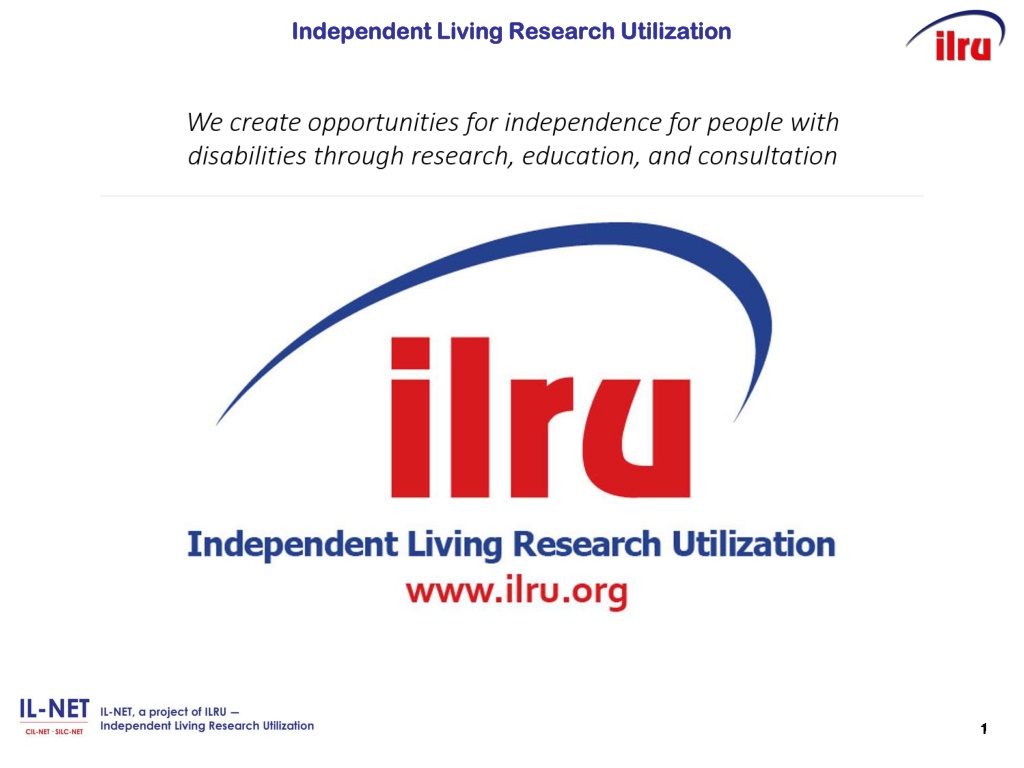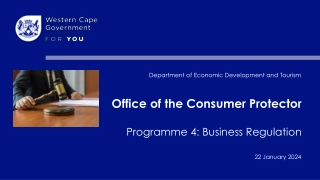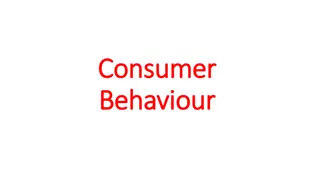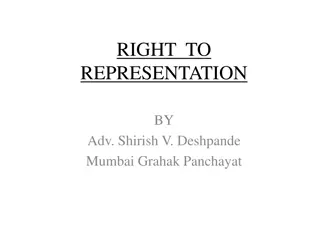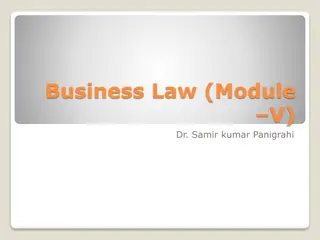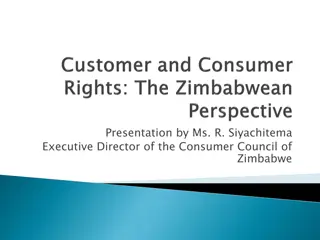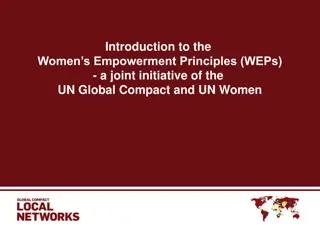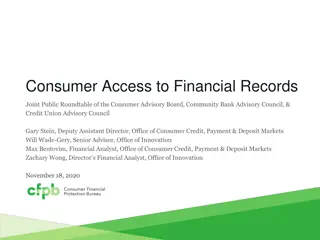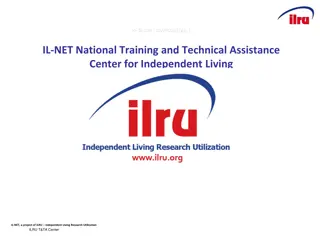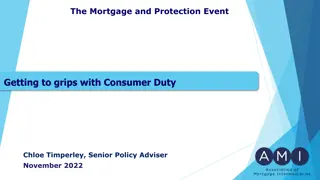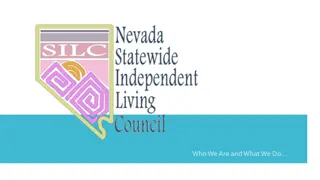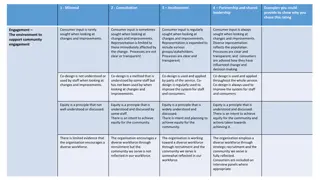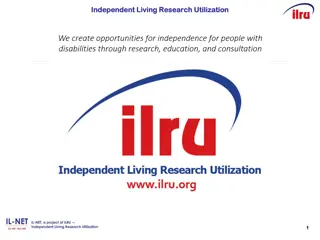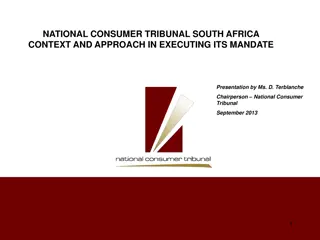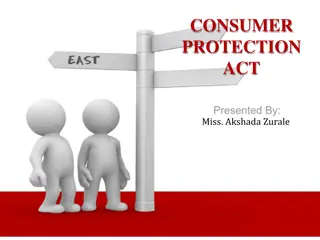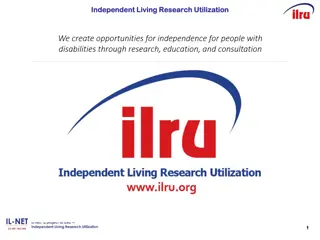Supporting Consumer Empowerment in Independent Living Programs
Explore how frontline staff at Able South Carolina provide Information and Referral (I&R) services, setting the stage for peer-to-peer relationships, consumer control, and empowerment. Learn about the importance of effective interviewing, goal-setting practices, and peer mentoring in creating a holistic consumer experience. Discover how a person-centered approach, empathy, and goal planning based on long-term visions empower individuals with disabilities to take control of their lives and achieve their goals.
Download Presentation

Please find below an Image/Link to download the presentation.
The content on the website is provided AS IS for your information and personal use only. It may not be sold, licensed, or shared on other websites without obtaining consent from the author. Download presentation by click this link. If you encounter any issues during the download, it is possible that the publisher has removed the file from their server.
E N D
Presentation Transcript
Independent Living Research Utilization Independent Living Research Utilization 1 1
Get to the Core of It: Get to the Core of It: Integrating CIL Core Services for a Integrating CIL Core Services for a Holistic Consumer Experience Holistic Consumer Experience Applying Effective Interviewing and Goal Applying Effective Interviewing and Goal- -Setting Practices that Support Consumer Control and Direction that Support Consumer Control and Direction Setting Practices Presenters: Presenters: Michelle Crain Michelle Crain Charlie Walters Charlie Walters May 2, 2018 May 2, 2018 Tempe, AZ Tempe, AZ 2
Able South Carolina Able South Carolina Frontline staff provide I&R. For prospective consumers, I&R is the precursor to intake (Meeting to establish ILP, etc.). These conversations set the stage for peer-to-peer relationships, consumer control, and empowerment. 3
Able South Carolina, Able South Carolina, cont d. 2 Federally required info and info specific to each case is collected. This is done by staff that intimately understand IL and the trajectory of consumer goals. We do not field calls from "them." We field calls from "us." Questions on employment, marital status, disability, educational status, and income bring about very common answers. "I'm disabled; I can't work." The way these responses are handled sets the stage for the process. cont d. 2 4
Able South Carolina Able South Carolina, cont d. 3 , cont d. 3 Peer mentoring and self-identifying as a person with a disability. Empowerment "I'm also a person with a disability, and I am employed." Empathy, Not Sympathy Intimate understanding of the barriers consumers and prospective consumers are facing. Practical, solution-oriented guidance provided. 5
Able South Carolina, Able South Carolina, cont d. 4 cont d. 4 This tone is set at the frontline & kept throughout the process. Goal planning with consumers ahead of signing an ILP takes this tone to the next level. Backwards planning based on people's vision for the life they want is simple. For many, it is a radical concept. (Backwards planning is beginning with a long-term vision for oneself and setting goals that one thinks will lead to that vision. In other words, goal planning with the end in mind.) For example, you may not set a goal of finishing a master s degree, but knowing that is your long-term aim may point you in the direction of taking a GED preparation class. Goals are worked out with consumers based on this vision and the effort they are willing to exert to get there. 6
Consumer Intake/ Initial Interview Consumer Intake/ Initial Interview The primary purpose of the consumer intake/initial interview is to help determine eligibility for IL services and to assist the consumer in identifying their strengths, resources, and potential barriers that may impact his or her ability to function independently in the community. Ultimately, this information is used to assist in the development of the consumer s ILP. Empower and encourage the consumer from the outset by informing him or her about the importance of this process being consumer-driven and directed. A good intake entails establishing trust, active listening and note-taking skills and effective documentation. 7
The Intake Setting The Intake Setting Consumer intakes may be conducted in different settings. Many CILs will accommodate a consumer s choice to meet at the center or in the home or respective community. The setting should be: mutually comfortable for the consumer and CIL staff; mutually accessible for consumer and CIL staff; maximizes the consumer s confidentiality; and, conducive to a focused and productive experience. 8
Gathering Essential Information Gathering Essential Information It is essential that CIL staff be prepared and organized for the intake process, as it is respectful of the consumer s time. CIL staff should have access to the CIL s data collection program, referral information, note-taking materials and any hard-copy or electronic forms. Explain the process, collect demographics and inform the consumer that some of the questions asked during the assessment may be intrusive, but necessary when trying to identify IL services and other community resources instrumental to meeting his or her established goals. 9
Determining Eligibility Determining Eligibility Encourage the consumer to speak freely about the functional limitations of the disability and the impact the disability has on his or her ability to function independently. Discuss and document how IL services will improve the consumer s ability to function more independently in the home, family and community. Notify the consumer in writing if he or she is determined to be ineligible, provide Client Assistance Program (CAP) information and assist with I&R, where appropriate. 10
Assessing and Planning Assessing and Planning After determining eligibility, the next major step in the IL process is following a logical sequence to develop the ILP or waived plan. Further assess: the nature and extent of the consumer's disability; the functional assets of the consumer; and the needs of the consumer to become or remain independent Engage in a Strength-Based approach, whereby the focus is on the consumer s abilities and not necessarily his or her limitations. 11
Identifying IL Goals and Services Identifying IL Goals and Services In the process of supporting consumers in identifying goals and action steps, it is important to use a Solution- Focused Approach Taking a positive perspective, as opposed to a negative perspective. Goals should be specific and focus on what the consumer needs to do. Once goals for independent living (IL) are established, assist the consumer in determining what services are required to achieve those goals. Each service should clearly support the achievement of consumer s goals and objectives; and be time-limited. 12
Identifying IL Goals and Services Identifying IL Goals and Services, cont d. , cont d. Examine the assessment information with the consumer. Discuss whether options are consistent with the consumer's needs and attributes. Ensure that the IL goal(s) meet identified consumer needs and expectations. This approach supports the consumer's ability to make informed choices about: suitable goals; services needed to achieve his or her goals; preferred methods and settings for service delivery; and, potential providers 13
Self Self- -Assessment Assessment What are the top three strengths you see in your intake/goal setting processes? What are three areas of improvement you see in those processes? 14
Scratching the Surface Scratching the Surface This session likely scratches the surface of a much larger conversation. To take things further, check out: An Introduction to Consumer Service Records, Independent Living Plans, and Service Coordination for CILs at http://www.ilru.org/introduction- consumer-service-records-independent-living-plans- and-service-coordination-for-cils 15
More IL More IL Resources Resources Interviewing and Assessing Needs (RapidCourse tutorial) - http://www.ilru.org/training/consumer- service-records-series Goal Setting with Consumers (RapidCourse tutorial) - www.ilru.org/training/consumer-service-records-series Effective Service Coordination: Engaging Consumers with a Holistic Approach to Independent Living (recorded video modules) - http://www.ilru.org/effective-service-coordination 16
Small Group Activity Small Group Activity 17
CIL CIL- -NET Attribution NET Attribution Support for development of this technical assistance information was provided by the Department of Health and Human Services, Administration for Community Living under grant number 90ILTA0001. No official endorsement of the Department of Health and Human Services should be inferred. Permission is granted for duplication of any portion of this information, providing that the following credit is given to the project: Developed as part of the CIL-NET, a project of the IL- NET, an ILRU/NCIL/APRIL/USU-CPD National Training and Technical Assistance Program. 18
